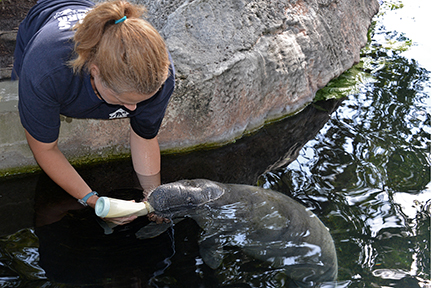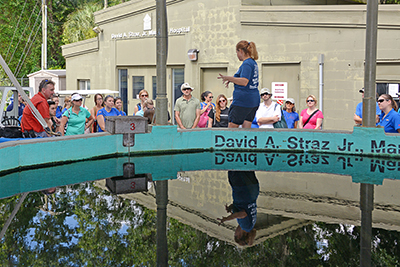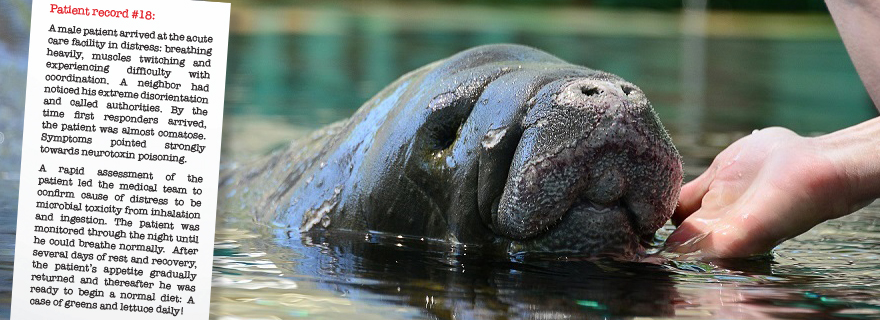[/su_pullquote]
Something out of the ordinary
For the record, this was no ordinary patient.
It was a male manatee that had ventured into a red tide bloom to feed and had been poisoned after eating contaminated sea grasses. This manatee was one of the lucky ones, because he was rescued and received critical care in time to save his life.
A manatee’s diet is no ordinary salad.
Eating as much as 10% of its body weight daily — up to 120 pounds — a healthy manatee under human care requires a high-nutrient mix of romaine, escarole and endive lettuces, supplemented with hydrilla and water hyacinths. Manatees recovering from distress may need encouragement to accept this diet, but by feeding them with other manatees, they quickly learn to like the new greens.
And of course, it is no ordinary hospital in which this fortunate manatee found itself beginning the road to recovery.

Rescued manatee babies demand constant care and feeding every three hours — or eight times a day — until weaned.
Managed care for manatees
The David A. Straz Jr. Manatee Hospital at Lowry Park Zoo is the only non-profit, acute care facility in the world specifically dedicated to manatee rehabilitation, and one of just three such rehab facilities contracted and federally permitted in the state of Florida. Since 1991, the manatee hospital has treated more than 350 manatees and reintroduced 200 back into Florida waters.
Tucked away at the back of the zoo property, many visitors don’t realize this unique facility exists or that they can witness the wonderful work being done. Just before Thanksgiving, I visited with Jaime Vaccaro, a member of the manatee team who has spent years watching the facility grow.
“It is an honor to work in a conservation program that is dedicated to the rehabilitation and release of sick, injured and orphaned manatees,” smiled Vaccaro. “It’s so important that we’re able to educate the public about manatees so they can appreciate and help this relic continue to survive in our Florida environment.”
The hospital and aquatic center includes two exhibit pools totaling 200,000 gallons for underwater viewing, three 16,500-gallon treatment pools with remote-controlled floors, life support systems, an amphitheater for daily educational talks, and a public viewing platform on the boardwalk.
The goal of the hospital is to return all manatees to their natural habitat. So if you visit, remember that none of the animals you are seeing are part of a permanent collection.
In 2013 alone, the zoo took in 34 manatee patients, and at the time I visited, 26 new patients had arrived so far in 2014. The rehabilitation team includes five keepers like Vaccaro as well as a curator and veterinary professionals. These dedicated individuals are eager to share heart-warming tales of rescue and recovery with visitors. Sadly, many of the maladies they find themselves treating are caused by manatees forced to live in close proximity to humans.
Common manatee hospital admissions result from:
Red tide:
In 2013, more than 800 manatee deaths were reported, and fully one third of them were due to the serious outbreak of red tide in the waters along southwest Florida. This toxic water condition results from the waste products of a natural bloom of the microorganism Karenia brevis. The unchecked growth of algae is exacerbated by nutrient run-off in the shallow coastal waters. (See related story page 6).
Researchers believe that manatees are exposed to the red tide toxins through three potential routes. First, the churning of the sea creates a toxin-laden aerosol that manatees breathe. Secondly, seagrasses can be coated with the toxins so the manatees ingest them with their food. And finally, the manatees can drink seawater that contains the toxins.
2013 was the worst year on record for manatee deaths due to red tide, with more than 270 animals killed over a 70-mile swath from Sarasota to Lee counties. In the past, researchers believed that red tide killed manatees when they breathed its toxins. But in 2013, biologists said manatees were sickened primarily because they consumed the toxins after they settled onto the seagrasses they ate.
“Seventeen of those manatees affected by red tide were transported to the Lowry Park Zoo hospital,” said Vacarro. “Our rehab team provided around-the-clock care until each manatee was able to swim and breathe normally, including floatation devices to help support the manatee’s airway.”
Boat injuries:
It is extremely rare to see adult manatees that have escaped scarring from boat propellers. In fact, researchers use those scars to recognize individual animals much as fingerprints are used to identify human beings. Fortunately, the animals heal naturally from many of these smaller scrapes. But even in waterways where power boats are not allowed, blunt trauma injuries can be caused by collisions with watercraft. Boaters may not even realize that the gentle thump they felt was a manatee hit, potentially causing broken ribs, punctured lungs and damaged internal organs.
The biggest danger from boat collisions is chest infection. Depending on the injury, the manatee may fill with air, becoming too buoyant to get underwater to feed. Or seeping fluids may make it so heavy that it is difficult to reach the surface to breathe.
Cold stress:
During the winter of 2010, the manatee hospital took in a record-high patient load of 23 distressed creatures. While manatees may look fat, their portly bodies are mostly muscle, not blubber. They cannot tolerate water below 68 degrees for extended periods of time. When exposed to low temperatures, they develop “cold stress syndrome.” Their face, flippers and tail edges will develop whitish lesions similar to frostbite in humans. Over time, the manatee becomes extremely stressed, which can lead to internal infections like pneumonia.
On several occasions, Vacarro has been part of the team that rehabilitates and releases cold-stressed manatees back into the wild. “Once an animal has fully recovered, we wait for the next cold snap to schedule the release,” she said. “Since manatees are migratory, we try to place them back into the body of water where we rescued them, or the spring they would most likely seek out during the winter months. The colder the weather, the more likely that there will be a lot of other manatees around or in the spring to get warm.”
Entanglements and ingestion:
Crab traps and monofilament fishing line create a deadly underwater maze for manatees. It’s not uncommon for the manatee hospital to treat an animal that has lost a flipper or part of a tail after they were entangled in discarded rope or line. The animal keepers at the zoo manage rehabilitation in recuperative pools, taking care of wounds and helping animals learn how to adjust to the loss of body parts.
Equally deadly are plastics – bags, bottle tops, and little pieces of all sorts that get lodged in the grasses upon which manatees feed. Once they are accidentally consumed, they can lodge in their digestive tract, causing a blockage that results in trouble eating and developing internal infections.

Right, Visitors can visit the manatee hospital at the back of the zoo property where members of the manatee team conduct informative tours of the rescue work being done here.
The next generation of manatees
Perhaps the most poignant rescue and release stories are the orphaned manatees the keepers raise. Manatees are excellent mothers, nursing their calves from teats under their front flippers for one to two years. Without that care from their mother, a calf will become dehydrated and show symptoms of low blood sugar levels within a couple days. The rescued baby demands constant care and feeding every three hours — or eight times a day — until weaned.
One of Vacarro’s favorite stories is how a lost calf found a family in the most unusual way. Kee, an orphaned baby arrived at the zoo first, already feeding from a bottle offered by keepers. The following month, Della arrived at the hospital due to a collapsed lung – the result of blunt trauma caused by a watercraft. Four days after being at the zoo, she gave birth to a male baby, who was named Pal.
Despite her injury, Della was successfully nursing her own baby. Eventually, her lung was healing so well that, on a chance, the zoo staff decided to introduce Kee to Della and Pal. To everyone’s joy, Della accepted Kee as her own and nursed the second baby as well. The story’s happy ending came when the family members were all released together into the St. Johns River, four months later.
Lettuce help
As with all good medical centers, the cost for building and maintaining manatee health care facility at the zoo comes at a high cost. As a not-for-profit entity, running the manatee hospital depends upon the generous support of donors like Tampa philanthropists David and Catherine Lowry Straz, Marylou and Jim Bailey, and TECO Energy to make the program a reality. In addition, the zoo dedicates $1 million of its own budget every year to manatee rehabilitation.
Still, it’s surprising to think that the zoo has to buy over $30,000 of lettuce and greens each month to keep the salad bar open for all those recovering manatee patients.
$1,000 a day? Now that’s an impressive Caesar salad!
To visit the David A. Straz Jr. Manatee Hospital:
Lowry Park Zoo, 1101 West Sligh Avenue, Tampa, FL 33604. Tel: 813-935-8552 or online at [su_button url=”www.lowryparkzoo.org” target=”blank”]Lowry Park Zoo[/su_button]
[su_note note_color=”#4094ad” text_color=”#ffffff”]MANATEE FACTS:
Florida’s state marine mammal is the manatee, a large aquatic relative of the elephant. They are grayish brown in color and have thick, wrinkled skin which is often covered in algae. Their front flippers help them steer, or sometimes crawl, through shallow water. They also have powerful, flat tails that help propel them through the water. Despite their small eyes and lack of outer ears, manatees are thought to see and hear quite well.
The average Florida manatee is about 10 feet long and weighs close to 1,200 pounds. Manatees can reach up to 13 feet in length and weigh up to 3,500 pounds. Female manatees tend to be larger than the males. Their newborn calves weigh around 66 pounds and are four feet long.
Although there is no precise census of Florida manatees, today’s population is estimated at approximately 5,000 individuals.
Learn more about manatees at [su_button url=”myfwc.com/manatee/” target=”blank”]Florida Fish and Wildlife Conservation Commission[/su_button]
[/su_note] [su_divider]